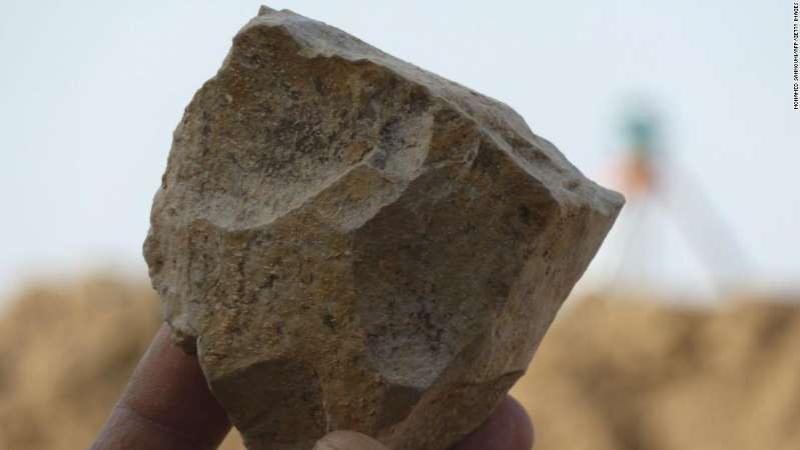Ancient tools found in North Africa could rewrite human origin story


The story of humankind may need to be rewritten.
A collection of 2.4-million-year-old stone tools has been found in Algeria, throwing into question the long-held theory that humanity emerged in East Africa.
The discovery of the 250 tools, found alongside 296 animal bones, suggests early humans were butchering meat in North Africa about 400,000 years before scientists had thought they arrived in the region.
It was previously believed that early humans, known as hominins, originated and stayed in East Africa for hundreds of millions of years, before beginning to move across the continent.
The new findings, detailed in the journal Science , were made at the Ain Boucherit site near the city of Setif, about 200 miles east of Algeria's capital, Algiers.
They resemble similar tools, known as Oldowan, which had previously only been found in the east of the continent, and predate other tools found nearby in the north by at least 400,000 years.
Researchers from Algeria, France, Spain and Australia were involved in the project, which involved 25 years of excavations.
East Africa hasn't yet lost its status as the cradle of humanity -- earlier tools dating back 2.8 million years have previously been found in Ethiopia.
But the authors made the tantalizing prediction that even older relics could still be uncovered near the site in Algeria, potentially opening up new avenues in the search for the origin of our species.
"Now that Ain Boucherit has yielded Oldowan archaeology estimated to 2.4 million years ago, Northern Africa and the Sahara may be a repository of further archaeological materials," they write.
"We suggest that hominin fossils and Oldowan artifacts as old as those documented in East Africa could be discovered in North Africa as well," they add.
'Multiple origin scenario'
While no human remains were found at the dig, the tools and animal bones showed strong evidence of human activity.
Some of the bones featured cut marks, indicating an early form of butchery, the authors wrote.
The discovery could indicate a "multiple origin scenario," where humans were making and using tools in different locations across the continent at the same time, they added.
Alternatively, it could mean that a "rapid expansion of stone tool manufacture" took place in the early days of humankind's existence.
Stone tools were found in China earlier this year that dated back 2.12 million years.
The archaeologists behind that project said their finds suggested that early humans moved out from East Africa and into what is now Asia.
The latest findings could tell a similar story, if earlier remains in North Africa are not found. But they would imply that humans were moving west, as well as east, from their birthplace.




More research that indicates our hominin ancestors were more advanced and widespread than previously thought. his is why I love science, there's always something new to see and learn.
I hope they find some bone fossils although my money would be on it being Homo habilis there is a small chance it could be Australopithecus africanus (or something else as yet undiscovered).
We are living in a truly exciting time for archaeology and anthropology. Ground penetrating radar, the system (I forget the name) that removes the canopy of the jungles that has found lost civilizations in south and central America.
This find/discovery is really interesting and hopefully there be more reported on it.
Thanks for the article Freefaller.
There are a few of us on NT that really get into this.
I think what you want is LIDAR.
That is it, thanks.
Your welcome Kavika. Like you I am waiting with baited breath for the first (of hopefully many) documentary on the ground explorations of the Central American discoveries
Anyone watch the science channel and catch the satellite mapping of Egypt project
which is revealing more roads, settlements, cities and Pyramids under the sand?
Incredible stuff.
SP I have seen and heard a little bit about (a few years ago I believe) I don't get that channel so haven't seen the show. But from what I heard it's going to keep the Egyptologists busy for quite some time to come.
Most people forget or are not aware that the region of current day Sahara Desert 2+ million years ago was a mixture of inland sea and lust forests and Savannah like grasslands. Good environments for hominids to evolve.
Ed good point and not only that it remained habitable until relatively recently
I love how the dates keep getting pushed further back on just about every month. Our past was filled with explorers and adventurers who were on the move much faster than we had thought before.
They are saying 3.3 million years for Kenya. There is much to ponder about our past and how we got here.
Some reading on Keyna can be found here, which is a few years old.
Good article Dave, just goes to prove we and all our hominin ancestors are an endlessly curious and inventive bunch.
This is pretty amazing stuff. I remember studying what is now called Paleo anthropology and they were still looking for the "missing link" Now we know, that humanoids were developing and possibly in different places. 40 years ago no one would have thought that humans and Neanderthals were hanging out together, but now we know better. I really think that this is just the iceberg. Great find freefaller!
Thank you Perrie, every find, every bit of knowledge gained is worthwhile and helps us learn what led to us.
I'll get back into this tomorrow, but now it's bedtime. Nite all
Good morning open for business again.